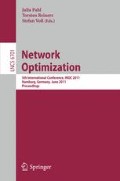Abstract
In this publication we examine a dynamic network flow problem, called the quickest cluster flow problem. This problem is motivated by evacuation planning and yields improved lower bounds on evacuation times. Our approach models people moving in groups rather than individually which can be observed even in the situation of an emergency. To the best of our knowledge, this fact has received little attention in dynamic network flow literature. Interrelations of this new model to existing network flow models like multicommodity flows are pointed out. The quickest cluster flow problem is proven to be NP-hard even on tree networks. We restrict the cluster sizes to pairwise divisible values and obtain an exact greedy-based algorithm.
Access this chapter
Tax calculation will be finalised at checkout
Purchases are for personal use only
Preview
Unable to display preview. Download preview PDF.
References
Ahuja, R., Magnanti, T., Orlin, J.: Network Flows. Prentice-Hall, Englewood Cliffs (1993)
Burkard, R., Dlaska, K., Klinz, B.: The Quickest Flow Problem. Math. Methods Oper. Res. 37(1), 31–58 (1993)
Garey, M., Johnson, D.: Computers and Intractability: A Guide to the Theory of NP-Completeness. Freeman, New York (1979)
Hamacher, H., Leiner, K., Ruzika, S.: Quickest Cluster Flow Problems. In: Proceedings of PED 2010 Conference (to appear, 2011)
Hamacher, H., Tjandra, S.: Mathematical Modelling of Evacuation Problems–A State of the Art. In: Pedestrian and Evacuation Dynamics, pp. 227–266. Springer, Heidelberg (2002)
Helbing, D., Farkas, I., Molnar, P., Vicsek, T.: Simulation of Pedestrian Crowds in Normal and Evacuation Situations. In: Pedestrian and Evacuation Dynamics, pp. 21–58. Springer, Heidelberg (2002)
Mawson, A.: Understanding Mass Panic and Other Collective Responses to Threat and Disaster. Psychiatry: Interpersonal and Biological Processes 68(2), 95–113 (2005)
Tjandra, S.: Dynamic Network Optimization with Application to the Evacuation Problem. Ph.D. thesis, TU Kaiserslautern (2003)
Author information
Authors and Affiliations
Editor information
Editors and Affiliations
Rights and permissions
Copyright information
© 2011 Springer-Verlag Berlin Heidelberg
About this paper
Cite this paper
Leiner, K., Ruzika, S. (2011). Quickest Cluster Flow Problems on Tree Networks. In: Pahl, J., Reiners, T., Voß, S. (eds) Network Optimization. INOC 2011. Lecture Notes in Computer Science, vol 6701. Springer, Berlin, Heidelberg. https://doi.org/10.1007/978-3-642-21527-8_29
Download citation
DOI: https://doi.org/10.1007/978-3-642-21527-8_29
Publisher Name: Springer, Berlin, Heidelberg
Print ISBN: 978-3-642-21526-1
Online ISBN: 978-3-642-21527-8
eBook Packages: Computer ScienceComputer Science (R0)

